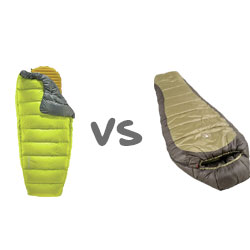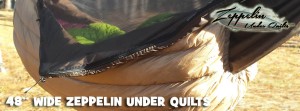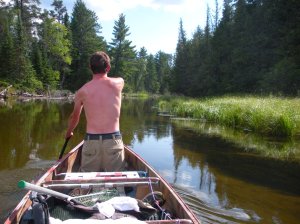“Every ounce of sleeping bag crushed flat under us as we sleep is an ounce of sleeping bag we’re carrying around every day for no reason.”
Scrolling through my phone yesterday, Google recommended an Appalachian Trail Thru Hiker data article put together by Appalachian Trials (now “The Trek“). Of course this sort of thru-hiker survey data is of the utmost interest to me so I naturally began to peruse the data to see what hikers are doing these days and some of the results really did surprise me.
Okay, to be fair I almost anticipated the data to reflect more silly things than I ultimately found but (both fortunately and unfortunately) I found that thru hikers in 2016 seem to be making some seemingly dumb mistakes in ways I didn’t quite anticipate.
Why You Should Get Rid of Your Mummy Bag:
Here’s some of the data from this year’s thru hiker survey on the Appalachian Trail according to TheTrek.co.
Surprisingly enough, it shows that 25.2% of hikers are now using backpacking quilts for sleeping in tents and tarps. In hammock sleep systems, about 33% of hikers are using top-quilts for insulation.
It’s crazy to me that a full 66% of hammock campers are making the mistake of carrying extra weight and taking up extra room in the pack by choosing to use a sleeping bag instead of the much more efficient top-quilt system (in this case combined with an under quilt for hammock use).
The problem with mummy bags
So what, exactly, is the mistake here? Well, let’s start by exploring how insulation works and how sleeping bags and quilts keep us warm.
At its most basic level, the majority of insulation operates by creating “dead air space” or a pocket of air which is unable to move. This immobile air is then brought up to body temperature since it sits close to the body. Since the air can’t move, it’s then quite efficient at helping to regulate body temperature.
For notation’s sake, it’s worth mentioning that this is only one type of insulation. See this Dr Energy Saver article for a good overall primer on how insulation works and some common problems with insulation.
Some challenges of insulation on the trail are wind, water, and compression. If your insulation gets wet it will lose a large amount of its ability to insulate. If wind is allowed to blow through your insulation it will replace all that warm air with cool (or cold) atmospheric temperature air. If your insulation gets compressed, or smashed, for any reason it will then also lose its ability to trap and retain warm body temperature air.
Wind and water are obvious, but can you think of an instance on the trail when you might accidentally compress your insulation?
Maybe you fold up that puffy jacket and sit on it for an improvised sit-pad. You might notice that it doesn’t do much to keep the bum warm. That’s because you compressed it – it’s no longer able to trap air because you crushed it flat with your body weight.
On the inefficiency of sleeping bags:
Since compressed insulation does little or nothing at all to help insulate us from cold temperatures, it follows that we should aim to avoid compressing any insulation we’re using. Right?
Traditional sleeping bags surround the body like a cocoon on all sides to keep us warm while we sleep. Unfortunately, a large portion of that insulation is crushed flat every night as we sleep. If we’re side sleepers we may crush less of that insulation than back sleepers.
Every ounce of sleeping bag crushed flat under us as we sleep is an ounce of sleeping bag we’re carrying around every day for no reason.
Because that insulation doesn’t actually help keep us warm, why bother carrying it at all? How do we solve this inefficiency?
Backpacking quilts are the answer! Backpacking quilts are simply mummy bags with open backs. There is no material on the underside of a quilt – the quilt simply drapes over you and, in some cases, snaps on to your sleeping pad to surround you without placing any material underneath you. This completely removes the material that would otherwise be crushed when sleeping in a traditional bag.
why The continued use of mummy bags surprises me:
When I first started using backpacking hammocks as a shelter back in 2011 (found Hennessey Hammocks at Trail Days in Damascus, VA) it seemed that only a select few backpackers knew about hammock camping at all. Those who did, seemed to fully understand the niche pros and cons of the shelter.
Though there seems to be little objective data available, my empirical experience is that camping hammocks have gained popularity like wildfire over the last 6 years. With them has come the rise of backpacking quilts.
Quilts seem to have sprouted largely from the hammock camping community where “under quilts” are used for insulation and comfort. I only became aware of the use of backpacking quilts as a result of getting to know cottage industry manufacturers in the hammock camping industry and ultralight backpacking world.
These days it’s much more common to hear people recommend the use of backpacking quilts on forums or by word of mouth. Apparently 25% of people are now using them and their use has grown 147% YoY (year over year).
Despite their weight savings when compared to same-temperature mummy bags and the fact that high quality quilts can be custom ordered to your exact specifications for less money than many name brand mummy bags at the local outfitter, mummy bags still own the majority of the market share. Why?
Better yet – according to the survey – why are 66% of hammock users still sleeping in mummy bags? This tells me that the hammock camping fad has become so popular so quickly that people are now hammock camping while thru hiking without even using properly researched equipment… By and large hammock campers rely on under quilts for insulation, they should really know better than to be sleeping in a mummy bag.
Why are mummy bags still so popular?
Mummy bags have been around for a long time and most big-name brands are making mummy bags and have models which have been popular for decades. Chances are your grandfather had a mummy bag and your dad did, too. It’s just the “thing” you “do” when you go camping.
By and large I believe the majority of hikers, backpackers, and campers in general don’t take the time to think or research their gear in great depth. Many people aren’t even aware that there are alternatives to mummy bags.
If you’ve bought all your gear at REI, then you’re probably not even aware that backpacking quilts exist or that you can order them to literally any temperature rating you would like. You may not be aware that they’re lighter than mummy bags, built by hikers for hikers, and more compressible than any other options on the market today.
I think mummy bags are still popular because the market is so saturated with them already. Most retail stores and manufacturers aren’t really looking out for consumers best interests. After all, backpacking quilts are superior to mummy bags in every way so why does the inferior product continue to exist? Most people expect to see mummy bags when they walk into an outfitter store and that’s what the box stores are happy to sell them.
Where to buy great backpacking quilts:
I’ll recommend one backpacking quilt maker above all others because I feel their balance of price to finished product weight and attention to customer needs is superior to all others. I have exclusively used Underground Quilts owned and operated by Paul McWalters for my quilts and tarps for years.
Paul makes my gear to my exact specifications every time, even when I ask for a snap or button to be left off to save weight. His company really goes the extra mile to make some great gear and I know him personally. Check out this great interview with Paul about his quilts!
I have meticulously researched and compared quilts made by other manufacturers and none of them have the price, weight, service, and product quality that I know I can expect from UGQ and Paul. Some very few may be lighter by fractional ounces, but the difference in price does not justify the weight savings in my opinion.
I have not and do not receive compensation for my opinions nor do I make money from sales of any manufacturer’s gear. They just make great quilts.
Other Quilt Manufacturers:
If you’re looking to compare quilts then check out these other makers:
Conclusion
I really can’t think of a great reason to keep mummy bags around except, perhaps, in the most harsh and extreme of cold environments such as arctic exploration. For any Appalachian Trail hike, a quilt is just fine even in winter.
With that said, it is my opinion that quilts should replace mummy bags and I sincerely hope to see 75% or more of hikers carrying quilts – not the other way around as the data currently reflects. They’re lighter and more compressible saving you energy, space, and potential injury on the trail.
Go chat with my buddy Paul at Underground Quilts and get yourself hooked up with a great new piece of gear – you’ll be glad you made the change.
Do you feel that mummy bags still have a place on the trail for most people? Leave me a comment and let’s keep the discussion going!
Happy Trails, people!










